Erica Jurus's Blog, page 3
May 13, 2025
Next stop: the Twilight Zone!
You’re traveling through another dimension – a dimension not only of sight and sound but of mind. A journey into a wondrous land whose boundaries are that of imagination. That’s a signpost up ahead: your next stop: the Twilight Zone!
Fiction writers love to play with the ‘what if’ scenario.
What if an ordinary girl meets the heir to a throne, only to have the prince’s parents disapprove? (The plot for an endless number of Hallmark movies.)
What if a massive rogue shark decides to use a coastal New England town as its personal buffet? (Jaws)
What if a man who’s recovering from a nervous breakdown sees a destructive gremlin on the wing of the airplane he’s flying in? Can he convince anyone that he’s not imagining things before the plane crashes? (Twilight Zone, S5, Ep3, “Nightmare at 20,000 Feet”)
Writer and producer Rod Serling loved to mess with our heads. He placed ordinary people in extraordinary situations and let us imagine what we’d do in their place. He was the creator of the brilliant, award-winning television series The Twilight Zone.
I watched the series avidly in syndication, and its imaginative twists and turns were the single greatest inspiration for my own writing, both as a child and adult. Come with me for a look back at what many consider one of the greatest television series of all time.
 Rod Serling – By CBS Television-CBS Portrait by photographer Gabor Rona-mark is faint in spots. – eBay itemphoto frontphoto back, Public Domain, https://commons.wikimedia.org/w/index.php?curid=22101341
Rod Serling – By CBS Television-CBS Portrait by photographer Gabor Rona-mark is faint in spots. – eBay itemphoto frontphoto back, Public Domain, https://commons.wikimedia.org/w/index.php?curid=22101341Rod Serling was a performer from an early age, mounting plays on a stage his father built for him in the family basement. He spent hours acting out dialogue from movies of pulp magazines, the cheap glossy magazines featuring sensational stories, including the likes of The Shadow, Doc Savage and Flash Gordon. He also spent a lot of time listening to horror, fantasy and thriller shows on the radio.
In high school he became something of a social activist, writing for and editing the school newspaper. He felt strongly about service in the military during WW2, and enlisted as soon as he graduated. The horrors of war shaped his later script-writing, such as the Twilight Episode “The Purple Testament”, which began with this intro: “Infantry platoon, U.S. Army, Philippine Islands, 1945. These are the faces of the young men who fight, as if some omniscient painter had mixed a tube of oils that were at one time earth brown, dust gray, blood red, beard black, and fear—yellow white, and these men were the models. For this is the province of combat, and these are the faces of war.” It was about a man who see in another man’s face if he was about to die in battle.
After the war ended, Serling used the federal G.I. bill’s educational benefits to enroll in college, where he began learning broadcasting, and that became the springboard for his career. But he quickly became frustrated with the socio-political climate of television shows, which were wary of producing anything that might be too ‘controversial’ in the eyes of the corporate sponsors. Any script he submitted that covered contemporary social issues became heavily watered-down. So he decided to create his own show using speculative fiction, where the messages he wanted to include could be couched in science fiction and fantasy; those genres weren’t as scrutinized. It was a premise that the series Star Trek used to good advantage down the road.
The new weekly series would be called The Twilight Zone.
 The series logo in a graphic; logo by the twilight zone – http://www.seeklogo.com/files/T/The_Twilight_Zone-vector-logo-2F75848C1B-seeklogo.com.zip, Public Domain, https://commons.wikimedia.org/w/index.php?curid=35129758 – image by E. Jurus, all rights reserved.
The series logo in a graphic; logo by the twilight zone – http://www.seeklogo.com/files/T/The_Twilight_Zone-vector-logo-2F75848C1B-seeklogo.com.zip, Public Domain, https://commons.wikimedia.org/w/index.php?curid=35129758 – image by E. Jurus, all rights reserved.Serling pitched a script called “The Time Element” to CBS for the pilot episode, but CBS used it for Westinghouse Desilu Playhouse, a new show produced by Desi Arnaz and Lucille Ball. The episode, about a man who recounts his vivid nightmares of the attack on Pearl Harbour to a psychiatrist, had what would become one of Serling’s trademarks: a twist ending. It was so popular with fans that CBS gave Serling the green light for his own series, and The Twilight Zone premiered on October 2, 1959.
The bulk of the scripts over the show’s five-year run were written by Serling, drawing largely on his own experiences from boxing and military life. During his time in the military Serling had been a good boxer, and used that experience to write a teleplay called “Requiem for a Heavyweight” for Playhouse 90, which won a Peabody Award.
Each airing featured his voice narrating the characteristic introduction that let viewers know they were departing the boundaries of the known world.
You unlock this door with the key of imagination. Beyond it is another dimension: a dimension of sound, a dimension of sight, a dimension of mind. You’re moving into a land of both shadow and substance, of things and ideas. You’ve just crossed over into… the Twilight Zone.
The episodes weren’t all science fiction – Serling used numerous genres to make viewers think, including fantasy, suspense, horror, thriller and even black comedy. There was often a moral to the story. In an episode I just watched again this past weekend, during a Twilight Zone marathon on television, “A Game of Pool”(Season 3, Episode 5), Jack Klugman plays a pool shark whose deepest and most obsessive desire is to beat a former legend of the game, James Howard “Fats” Brown, played by Jonathan Winters. When “Fats” Brown shows up from beyond the grave to play him…well, I’ll let you watch it to find out what happens, and why you should be careful what you wish for.
 Two state troopers investigating a report of a spaceship crash in “Will the Real Martian Please Stand Up” – image from YouTube.
Two state troopers investigating a report of a spaceship crash in “Will the Real Martian Please Stand Up” – image from YouTube.Every episode then had its own opening narration to set the stage. For my favourite episode, “Will the Real Martian Please Stand Up?”, it was:
Wintry February night, the present. Order of events: a phone call from a frightened woman notating the arrival of an unidentified flying object , then the checkout you’ve just witnessed, with two state troopers verifying the event – but with nothing more enlightening to add beyond evidence of some tracks leading across the highway to a diner. You’ve heard of trying to find a needle in a haystack? Well, stay with us now, and you’ll be part of an investigating team whose mission is not to find that proverbial needle, no, their task is even harder. They’ve got to find a Martian in a diner, and in just a moment you’ll search with them, because you’ve just landed – in The Twilight Zone.
As you watch events eerily play out inside the diner, it’s clear that there’s one extra person from a busload of passengers halted by a snow storm. Despite how normal everyone looks, one of them shouldn’t be there, and suspicions fly. If you pay close attention, you’ll figure out who the invader is, and perhaps you’ll guess the extra twist at the end.
“Nightmare At 20,000 Feet” is probably the best known episode, featuring a young William Shatner and a gremlin outside chewing up the airplane wing that only Shatner’s nerve-wracked character seems to see. My hubby and I often joke about seeing something outside the window when we fly – it’s a good thing we’re not nervous fliers. Shatner himself reports that even today when he flies a fan will occasionally recognize him and ask “Do you see anything on the wing?”
Shatner wasn’t the only Trekker to appear on the show – Leonard Nimoy appeared in the episode “A Quality of Mercy”,
It’s August, 1945, the last grimy pages of a dirty, torn book of war. The place is the Philippine Islands. The men are what’s left of a platoon of American infantry, whose dulled and tired eyes set deep in dulled and tired faces can now look toward a miracle, that moment when the nightmare appears to be coming to an end. But they’ve got one more battle to fight, and in a moment we’ll observe that battle. August, 1945, Philippine Islands. But in reality, it’s high noon in the Twilight Zone.
The series featured many actors who were well-known at the time or subsequently, from Mickey Rooney to Charles Bronson to Carol Burnett to Robert Redford. Many of these renowned performers later confessed that they weren’t necessarily proud of their performances. The Twilight Zone‘s budget allocated most of the money per episode to sets and special effects, which meant that the actors had only one take to cement their scenes.
Serling’s own two favourite episodes were:
“The Invaders”, with Agnes Moorehead playing an old woman who finds a tiny spaceship and its alien crew of two on the roof of her farmhouse. They attack her and she manages to kill them, but of course there’s a fascinating twist at the end.
“Time Enough at Last”, with Burgess Meredith as a meek, myopic bank teller who just wants some time to indulge in his favourite pastime, reading, denied at every turn by his mean-spirited wife. When he happens to survive a nuclear war inside one of the bank vaults, he’s finally given that time, but…
The Twilight Zone received two Emmy nominations (for cinematography and art design), but didn’t win. However, it collected three prestigious Hugo Awards for “Best Dramatic Presentation.
It inspired me to let my imagination soar, along with likely thousands of other budding writers. You might recognize a couple of them: Stephen King, J.J. Abrams and George R.R. Martin. That’s what great storytelling does, a legacy that maybe my own novels will leave some day.
Check out Screen Rant’s list of the 25 Best Episodes Of The Twilight Zone Ranked for more nostalgia and information.
This highway leads to the shadowy tip of reality: you’re on a through route to the land of the different, the bizarre, the unexplainable…Go as far as you like on this road. Its limits are only those of mind itself. Ladies and Gentlemen, you’re entering the wondrous dimension of imagination. . . Next stop The Twilight Zone.
May 6, 2025
Comic Con Pandemonium
Every year, May 8th celebrates Make a Book Day. It challenges people to ‘channel their inner author’.
Well, five years ago I did just that. I had no idea what would happen when I began setting down my idea for a genre-crossing, off-trend urban fantasy/sci-fi trilogy. But nothing is ever gained without trying, and during the first lockdowns in 2020 I began with the words that had been in my head for a long time:
“Do you think you know me? I promise you, you don’t.”
The words of narrator Romy Ussher, recounting her wild journey from unsuspecting professional archivist to a creature who might bathe the galaxy in death – you’ll have to read the final book in the trilogy, Out of Time, to find out whether she can hold on to her humanity or not.
It’s been an epic journey for me as the author, and what better way to celebrate the completion of this part of the Chaos Roads saga (while the trilogy is finished, there will be more stories coming out of the strange town of Llithfaen) than to launch the finale at a huge local event. On May 30th I’ll be standing in my very dramatic booth, with two of my friends as helpers, along with my all-purpose creator and roadie hubby, as more than 30,000 people begin to mill through in search of fun.
Quite a few people have asked if I’ll be in costume, and as much as I love dressing up for Halloween, at Comic Con I have three long days on the floor, so comfort is my highest priority. And my novels aren’t well-enough known to produce a recognizable costume. I can tell you, though, that I’ll be a very cool author. A wise fellow author recommended wearing your brand at appearances, and so far that’s worked very well for me, but I’ll kick it up a notch for the convention. Think: a little glam mixed with slightly goth. I will post photos post-event 
So there’s a section of my closet set aside for specific outfits for each day. And the lower level of our house has become the storage space for all my supplies.
We have two portable power generators so that we don’t have to depend on an external supply (it can be arranged at this venue, but not at all of my appearances, so it feels good to be self-reliant.
There are two gel floor mats rolled up in a box for me and my helpers to stand on for up to ten hours in a day. A 19” monitor will play a couple of messages, one for the draw prize and one to introduce a small game I’ve created. Cash box with a float, and a Square reader for electronic payments. Various stands to hold books and other things. Tablecloths, a branded table runner, a table-top sign, signs for pricing, cables and cords… It’s a long list.
I have a tableful of decorations for my booth, and a couple of surprises. My dark, moody booth décor has gone over very well in single-table iterations at recent book signings, and one family said they’re really looking forward to seeing the entire booth at the Con.
And there are piles of merchandise – two boxes of my new mugs (very cool, I have to say), a stack of boxes of books (including Book 3 – very exciting!), a container of e-reader charms (both USB-C and Lightning plug-ins), a box of bookmarks, one of business cards, a shipment of Roads Troublemaker t-shirts on the way, and a companion Journal in the proofing stage.

Based on a very smart suggestion on another author blog, I’ve created an inventory spreadsheet of all the things we need to make sure we transport to Niagara Falls. They’re all critical, both to arrive at the Convention Centre and to come back home with us at the end of the event (except all the merchandise we hope will sell out, of course  )
)
Thursday, May 29th is “Load-In” Day, when my hubby and I, along with around 200 other exhibitors, will be manhandling our way from the loading docks to our booth. I haven’t received my booth number yet, so check my Instagram feed for that info, hopefully coming soon.
Yup, it’s a lot, far more than I’d really anticipated, but we’re having great fun pulling it all together (although my hubby claims I’ve turned our home into a sweatshop where he works for no wages 
It’s not a cheap undertaking, either, but we consider it an investment. Last year the convention had over 30,000 visitors – hard to beat that for better exposure to my novels. (Hence the heightened booth setup and activities to attract as much attention as possible.)
We’re getting down to the wire now – just roughly three weeks to go! May is very much a literary month – May 3rd was Wordsmith Day, May 8th is Make a Book Day, May 22nd is Sherlock Holmes Day – so it seems like the perfect time to launch the grand finale to my trilogy. I’m very excited, and I hope to see some of you at Niagara Falls Comic Con to celebrate with me!
April 29, 2025
The Titanic sinking – new evidence
“My mother had a premonition from the very word ‘GO.’ She knew there was something to be afraid of and the only thing that she felt strongly about was that to say a ship was unsinkable was flying in the face of God. Those were her words.”
Eva Hart, Titanic Survivor
This year marks 113 years since history’s most famous ship had its hull ripped open by a massive iceberg and sank into the icy waters off the coast of Newfoundland. The event still resonates even today – for me, April is forever Titanic month.
There’s something indelibly haunting about the ship that was built to the ultimate standards of Edwardian technology, that was created to be a floating lifeboat, that nothing could defeat. But White Star Line, who commissioned the ship, and Harland & Wolff, the builders in Belfast, Northern Ireland, were dreadfully wrong.
 Harland & Wolff, Titanic’s builders, still operate in modern-day Belfast. This is one of their big yellow gantries. By E. Jurus, all rights reserved.
Harland & Wolff, Titanic’s builders, still operate in modern-day Belfast. This is one of their big yellow gantries. By E. Jurus, all rights reserved.In 1912 the massive, luxurious ship set sail across the ocean with beautiful architecture, sumptuous food supplies, and spaces for the extremely wealthy to store all of the trunks of clothing for each change of outfit for the duration. It all went down into the dark depths of the ocean on the night of April 14th, only four days later, along with approximately 1,500 passengers.
I delivered a talk about the final dreadful hours of the Titanic, along with the PTSD of the survivors, at our local library for the 100th anniversary, and it was a packed house. So many people in the decades since the sinking have been emotionally touched by the disaster.
Everything that I’ve read on the subject points to a perfect storm of circumstances, the absence of any one of which might have led to a different outcome – if the binoculars for the watch hadn’t mysteriously disappeared, if an unusual amount of icebergs hadn’t drifted down through Iceberg Alley that season, if the resulting night hadn’t been so cold that ice crystals in the air obscured the spotters’ vision, if the captain had heeded the reports of all the icebergs and slowed down…
So many turning points, so many opportunities to avoid catastrophe. And all the while, the wealthy and the humble were celebrating their passage on the inaugural sailing of the famous new ship, completely unaware of what lay ahead. I believe that’s why we can’t seem to let the sinking go.
A few years ago, when my hubby and I were travelling to Ireland, I particularly wanted to visit Belfast, to stand where the great ship began her journey.
 Me, standing on the Titanic’s actual slip way in Belfast. By E. Jurus, all rights reserved.
Me, standing on the Titanic’s actual slip way in Belfast. By E. Jurus, all rights reserved.That was amazing. We even stayed in the Titanic Hotel, built as an extension to the original Harland & Wolff drafting offices. The hotel is directly across the street from the Titanic Museum and the slip yards where Titanic and her sister ship Olympic were launched into the sea. There are outlines on the pavement marking where the two ships rested, and those for Titanic have an evocative chalk-outline quality to them. Visitors can stand right where the ship entered the water. You want to yell, “Don’t go!”, as if you could talk to the launch crew across time.
The hotel is atmospheric, with a vintage nautical design. It’s surprisingly affordable, and the perfect place to centre your Titanic pilgrimage. One of the drafting offices has been turned into a bar and restaurant, and you can even gently unroll some of Harland & Wolff’s original blueprints from that era.
 Part of our room at the Titanic Hotel in Belfast, Northern Ireland. By Erica Jurus, all rights reserved.
Part of our room at the Titanic Hotel in Belfast, Northern Ireland. By Erica Jurus, all rights reserved. Our luggage tags from the Titanic Hotel, Belfast. By E. Jurus, all rights reserved.
Our luggage tags from the Titanic Hotel, Belfast. By E. Jurus, all rights reserved.The Titanic Museum is wonderful, with an exterior that mimics the shape of an iceberg, and an interior filled with information about the industries in Belfast – there were many – that supplied for the ships being built, from rope-makers to linen-weavers to food purveyors; with memorabilia from the ships; and with the poignant messaging sent in desperation after the Titanic was hit.
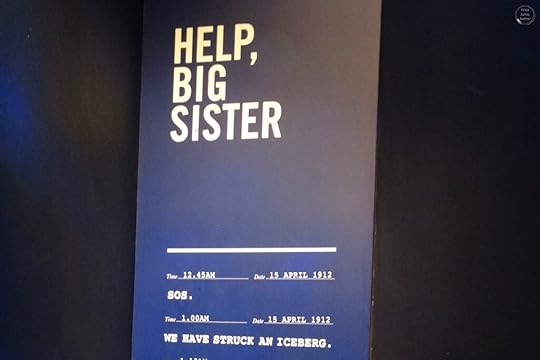 One of the heartbreaking emergency messages sent out by the Titanic, highlighted in the Titanic Museum. By E. Jurus, all rights reserved.
One of the heartbreaking emergency messages sent out by the Titanic, highlighted in the Titanic Museum. By E. Jurus, all rights reserved.But it was the child’s luggage on board the SS Nomadic, the last remaining tender boat (that would ferry passengers from land out to the enormous ship waiting out on the water) for the Titanic now dry-docked in Belfast, with a stuffed toy accompanying it, that really got to me. Fifty-three sets of parents had to watch their children perish in the ocean along with them.
 A sample of a first-class child’s luggage on board the SS Nomadic tender boat. By E. Jurus, all rights reserved.
A sample of a first-class child’s luggage on board the SS Nomadic tender boat. By E. Jurus, all rights reserved.All such tragedies are terrible, unimaginable. The citizens of Belfast in 1912 were devastated that the ship they’d helped build, in which they took great pride, had gone down. The event remains the best-studied disaster in history, with every available record pulled from around the world.
And researchers are inspired to keep trying to determine exactly what happened. I think the story speaks for itself, just a horrifying mountain of circumstances that took the great ship down, but people continue to look for more answers.
A recent study used submersible robots to map the wreck, 3,800m down on the bottom of the Atlantic, as a detailed 3-D model. What the researchers found illuminated the ship’s final hours. The replica shows the violence of the ship tearing in two as it sank: while the bow still remains upright, the stern landed 600 metres away, its metal mangled from the impact.
One of the boiler rooms visible provides evidence that the ship’s engineers worked right to the end to keep the ship’s lights on so that as many passengers as possible could escape.
A simulation of the sinking demonstrated that as the ship scraped along the iceberg, a series of relatively small punctures, each about the size of a standard sheet of copier paper, were created in a line along the hull.
The ship should have stayed afloat if four of its watertight compartments became flooded. But those holes, tiny compared to the mass of the ship, opened up six compartments to the water, and not all of them were watertight. As each one successively filled, the water cascaded over the top into a successive compartment. Eventually, there was so much water inside that it took the Titanic down to her grave.
You can find the article on the BBC website with more details.
 Some of the Titanic-related books in my collection, including two from the Titanic Museum in Belfast. By E. Jurus, all rights reserved.
Some of the Titanic-related books in my collection, including two from the Titanic Museum in Belfast. By E. Jurus, all rights reserved.And perhaps you’d care to commemorate the great ship and her passengers by hosting a Titanic dinner. One of my favourite Titanic-related books in my collection is Last Dinner on the Titanic, which will provide you with menus for all classes on the boat, and give you all the detail you need to create the right atmosphere. Dressed in your finest, you might raise a glass to all of the doomed souls that spent four days of gaiety before the terror set in.
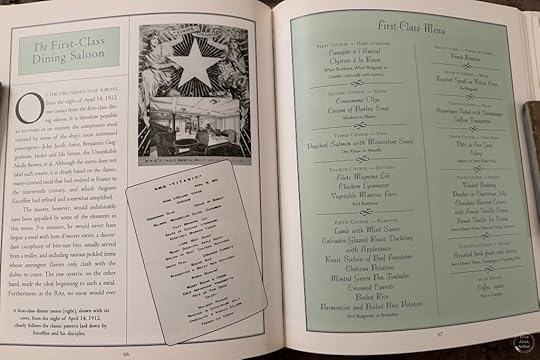 Illuminating pages from “Last Dinner on the Titanic”. By E. Jurus, all rights reserved.
Illuminating pages from “Last Dinner on the Titanic”. By E. Jurus, all rights reserved.
April 22, 2025
Still on hiatus
Apologies, we were delayed getting home from a weekend getaway by a road closure on the 403 highway, which is still in effect. We’re very glad to be home, and please check back for the full blog next week.
April 15, 2025
On hiatus this week
Must get the book uploaded this week in order to have printed copies for the big Comic Con launch! See you next week; enjoy the long weekend.
April 8, 2025
The Sad Demise of National Novel Writing Month
As I’m finishing the final edit of my third novel, the book that wraps up the epic story I began scribing five years ago, I’ve been saddened to hear that NaNoWriMo, the nickname of the National Novel Writing Month organization, is closing its virtual doors.
The nonprofit, founded in 1999 to give aspiring writers the support to try putting together our first novel, has been plagued by issues over the past couple of years.
The idea of National Novel Writing Month was to try and write 50,000 words in 30 days. No editing, no pressure to make it perfect, just to get that story out of your head and onto ‘paper’, where you could then do something with it.
I’d dabbled with the annual November writing sprint earlier, but was still working full time and just couldn’t get into it.
By 2020, however, I’d retired, coincidentally just as the COVID juggernaut rolled across our planet and we all became more-or-less trapped in our homes. My hubby was an essential worker, so he was still getting out of the house several days a week, but my nascent retirement plans to pop in and visit my coworkers and/or go out for coffee from time to time had all gone up in smoke. I had nothing to do, other than wait in long lines to get into a grocery store.
We bought a bread machine and I baked a lot of different loaves, so that was fun. I baked sweets regularly for Afternoon Tea when my hubby got home from work every day, a little treat in the messed-up scenario we were all living. We started putting on weight, so that had to moderated a bit.
In the summer months I began visiting our local botanical garden, where I could walk around in the fresh, breezy air without a mask, letting Nature take some of the edge off my cabin fever, and even chatting (at a safe distance) with the handful of other visitors who were eager for any kind of new conversation.
But my thoughts kept returning to three books I’d always wanted to write – a memoir of our crazy travels together (much requested by family and friends), a self-help book about growing through getting outside your comfort zone, and this kind-of-epic urban fantasy/sci-fi story that had been living in my head for a while, unformed but persistent.
Despite the outlines I had for the two non-fiction books, that darned fiction book was just bugging the hell out of me. It wanted to come out, no matter how much I told it that a non-fiction book would be faster to write, and probably more lucrative.
And so, I decided to join NaNoWriMo in earnest that fall. I told my hubby that I wanted to give it a shot, and that I’d be tied up writing for a good part of each day. He didn’t poo-poo the idea, even though I had absolutely no idea if I could do it. But one of my maxims has always been ‘you’ll never know unless you try’.
Participating in NaNoWriMo was really exciting. There were Discord discussion groups you could join to share the journey with people writing in your own genre, or any other kind of common bond you might imagine. You logged your progress on the NaNoWriMo website every day – at least I did – and it gave you little achievement badges.
 My progress chart from writing the first book – by E. Jurus, all rights reserved
My progress chart from writing the first book – by E. Jurus, all rights reservedI calculated that to make the 50,000-word goal I’d have to write at least 1,600 words a day and I persevered, sometimes writing more, sometimes less. I had a rough outline going into the event: I knew where the story was going to begin and to end, and I’d always known that it would become a trilogy. Those were my signposts along the way if I felt I was getting lost or overwhelmed.
And I won’t lie, it was a grind. But, to my enormous surprise, I flat-out loved it! Once I got began telling the story of Romy Ussher and the insane supernatural world she was unwillingly dragged into, the whole thing truly took on a life of its own and I was along for the ride.
By November 30 I’d crossed the finish line. I’d written 50,520 words, and I had the makings of an entire novel. I kept going, taking a break through December for the holidays. Romy and the other characters began surprising me, and the story I’d worried about being able to fill a book with grew to fill the trilogy I’d planned. I got Romy to the dreadful, cliffhanger ending of book 1 on July 31st, 2021, and with trembling fingers typed “The End”.
Holy shit, I’d written a book. I’d bought a bottle of our favourite champagne beforehand just in case, and the next day my hubby and I cracked it open with some family members to celebrate.
After letting the book rest for a bit, I edited it, recruited a group of beta readers to see if it was anything worth reading, and that November started into book 2. In November 2022 I embarked on the mammoth task of book 3, the grand finale, having earned some passionate fans of the first two novels. Next month I’ll be launching book 3, Out of Time, in style at Niagara Falls Comic Con, hoping to entice some of the 30,000+ visitors to my booth to have a look.
NaNoWriMo shepherded me through this entire wonderful, bucket-list journey. It was my safe space to try out my ideas among thousands of other writers just like me. Some famous novels have come out of that event, including The Night Circus, by Erin Morgenstern, and Water for Elephants, by Sarah Gruen. For three years I looked forward to November.
However, In November 2023 I received an email from my Municipal Liaison (ML) that there were some ongoing concerns about forum moderation.
 Email message header, the first intimation of problems – by E. Jurus, all rights reserved
Email message header, the first intimation of problems – by E. Jurus, all rights reservedEach region had an ML to oversee and moderate chats among participants. Before COVID, write-ins were often held in person, at local cafes or other spots where we could gather and do writing sprints. Everything became virtual in 2020, which is the year I seriously embarked on my journey.
Our ML was great, and in the discussion boards I saw her handle unruly participants with grace and aplomb. But as you might imagine, with over 400K people joining each year (amongst the various programs running throughout the 12 calendar months), it had to be a challenge keeping everyone polite.
According to our ML, there hadn’t been any issues locally, but on the global stage, the words “lawyers and law enforcement” came up. The MLs didn’t know what was going on at that point, but many of the regional forums shut down.
Far beyond cranky participants, it turns out that at least one ML was grooming, in the worst sense of the word, young participants in one of the Young Writers Program forums. It’s heartbreaking that someone chose to take advantage of such a great program.
Then apparently there were financial issues, which the nonprofit has cited as the main reason for shutting things down.
But there was also what I call AI-Gate. When AI tools began to proliferate, NaNoWriMo’s stance was that “to categorically condemn AI would be to ignore classist and ableist issues surrounding the use of the technology, and that questions around the use of AI tie to questions around privilege.” Well, that put up the backs of thousands of writers who feel that we are creators, from all walks of life, and proud of our work.
The New Yorker published an essay by Ted Chiang called AI Isn’t Going To Make Art, in which he wrote “What I’m saying is that art requires making choices at every scale; the countless small-scale choices made during implementation are just as important to the final product as the few large-scale choices made during the conception… Generative A.I. appeals to people who think they can express themselves in a medium without actually working in that medium.”
A fellow in one of my Facebook author groups actually asked if he could call himself the author of a book written for him by an AI program! Hard no.
Now, hiring an editor is a very expensive proposition. They charge by the word, so to have run my roughly 190K-word first book past an editor would have cost me in the neighbourhood of $4,000, which I didn’t have. I’m very lucky that I learned structure, grammar and proofreading early on in school, and have done it professionally at times in my varied careers, along with writing articles and media copy. Not everyone had/has that advantage.
BUT, I think the process of learning those skills is critical. Published writers always advise aspiring writers to read a lot of good writing, anything from novels to great pieces of journalism. Learning how to articulate your ideas well enough to bring them to life for readers is essential to becoming a good writer. And there are plenty of courses available.
Needless to say, a lot of passionate writers were really taken aback by NaNoWriMo’s position, and began to pull away. It turned out to be a serious misstep on NaNo’s part.
And so, tragically (and I do mean that very word), a great writing initiative is slipping away. I can’t tell you how many aspiring writers I’ve recommended it to since I first set foot in its waters – some just a couple of months ago. I’m sad that they’ll now never be able to experience the camaraderie and rush of NaNo Novembers, and the feeling of accomplishment. I tip my hat to the original organizers for taking a tiny idea and turning it into something truly wonderful, with my personal thanks for giving me the opportunity to become an author.
April 1, 2025
Found sequel of Merlin and King Arthur
There likewise I beheld Excalibur
Before him at his crowning borne, the sword
That rose from out the bosom of the lake,
And Arthur rowed across and took it — rich
With jewels, elfin Urim, on the hilt,
Bewildering heart and eye — the blade so bright
That men are blinded by it — on one side,
Graven in the oldest tongue of all this world,
“Take me,” but turn the blade and ye shall see,
And written in the speech ye speak yourself,
“Cast me away!”
Alfred, Lord Tennyson, Idylls of the King, The Holy Grail
 The Story of King Arthur and his Knights by Howard Pyle (1902)., Public Domain, https://commons.wikimedia.org/w/index.php?curid=1878115
The Story of King Arthur and his Knights by Howard Pyle (1902)., Public Domain, https://commons.wikimedia.org/w/index.php?curid=1878115The tales of King Arthur, Guinevere, Lancelot and Merlin the Sorcerer rise from the mists of early Britain, steeped in ancient magic and mayhem.
Arthur, or Artorius, is speculated to have been an actual historic figure in 5th or 6th century Britain, which, after the departure of the Roman conquerors, was divided between a number of fractious factions that fought incessantly. Under threat of invasion by Anglo-Saxons, however, Arthur was able to unite the kingdoms into one and lead them to victory in the Battle of Badon. This battle is accepted as historical fact. The rest is all legend.
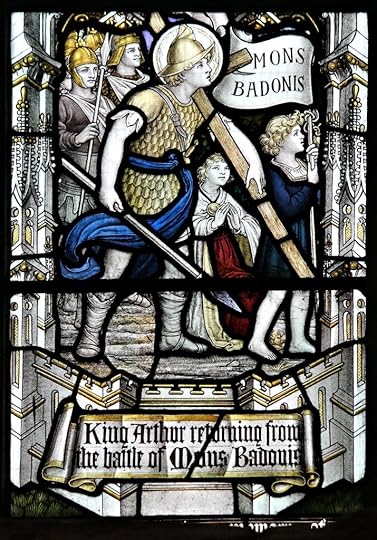 King Arthur returning from the Battle of Mons Badonis (or Mount Badon). First reference to Arthur, found in early Welsh literature. Stained glass in Llandaf Cathedral, Cardiff. By Llywelyn2000 – Own work, CC BY-SA 4.0, https://commons.wikimedia.org/w/index.php?curid=48360828
King Arthur returning from the Battle of Mons Badonis (or Mount Badon). First reference to Arthur, found in early Welsh literature. Stained glass in Llandaf Cathedral, Cardiff. By Llywelyn2000 – Own work, CC BY-SA 4.0, https://commons.wikimedia.org/w/index.php?curid=48360828The story really begins with the birth of Merlin, said to be a “cambion”, an old word for the child of an incubus demon and a human woman (in this case a nun, the daughter of the King of Dyfed). (Those darned incubi, they loved to corrupt religious virgins.) Born with the ability to speak like an adult and a variety of supernatural skills, baby Merlin is tainted by his bloodline and is destined to become a version of the Antichrist, until he’s baptized by a priest named Blaise and freed from the influence of Satan.
Merlin has knowledge of the past, present and future. When Uther Pendragon, king of all Britain, develops the hots for Igraine, the lovely wife of Gorlois, the Duke of Cornwall, he asks Merlin to use his magic to help Uther seduce her. Merlin agrees, for a price:
“this is my desire: the first night that ye shall lie by Igraine ye shall get a child on her, and when that is born, that it shall be delivered to me for to nourish there as I will have it; for it shall be your worship, and the child’s avail, as mickle (very large) as the child is worth.”
Sir Thomas Malory. Le Morte d’Arthur: Volume 1
 The Birth, Life, and Acts of King Arthur, of His Noble Knights of the Round Table, Their Marvellous Enquests and Adventures, the Achieving of the San Greal and in the End Le Morte d’Arthur, with the Dolorous Death and Departing Out of This World of Them All, two volumes. First Beardsley edition of Malory’s Arthurian epic, vellucent binding by Cedric Chivers, hand-painted after Beardsley’s own artwork within. London: J. M. Dent, 1893. Large square octavo (240 × 192 mm). By Cedric Chivers / Aubrey Beardsley – https://pictures.abebooks.com/inventory/30649265604.jpg, Public Domain, https://commons.wikimedia.org/w/index.php?curid=119265094
The Birth, Life, and Acts of King Arthur, of His Noble Knights of the Round Table, Their Marvellous Enquests and Adventures, the Achieving of the San Greal and in the End Le Morte d’Arthur, with the Dolorous Death and Departing Out of This World of Them All, two volumes. First Beardsley edition of Malory’s Arthurian epic, vellucent binding by Cedric Chivers, hand-painted after Beardsley’s own artwork within. London: J. M. Dent, 1893. Large square octavo (240 × 192 mm). By Cedric Chivers / Aubrey Beardsley – https://pictures.abebooks.com/inventory/30649265604.jpg, Public Domain, https://commons.wikimedia.org/w/index.php?curid=119265094Uther is so filled with lust that he agrees. Merlin then transforms Uther into the likeness of Igraine’s husband, and himself and one of Uther’s men into the appearance of knights already at the castle of Tintagel. The magic works, Igraine sleeps with Uther, and the child who would be a future king – Arthur – is born.
The rest of the story has been told and retold many times over the centuries, and in modern times in movies and television series. It’s compelling legend – Merlin’s raising and mentoring of the boy into the man, Arthur’s gifting of the magical sword Excalibur by the Lady of the Lake, his marriage to Guinivere, the building of Camelot and the formation of the Round Table, Guinivere’s tragic affair with the noble Lancelot, and much more that’s been romanticized and embellished by several medieval authors. Personally, I think the 1981 movie Excalibur, by John Boorman, is a fantastic recreation of the times and the legends.
In the end, King Arthur is mortally wounded by his own ambitious son, Mordred (with a name like that, how could he not be evil), returns the sword to the lake, and is taken to the mystical Isle of Avalon, his final resting place … until Britain should need him once again.
Merlin enters a cave and falls into an endless sleep, awaiting the return of Arthur.
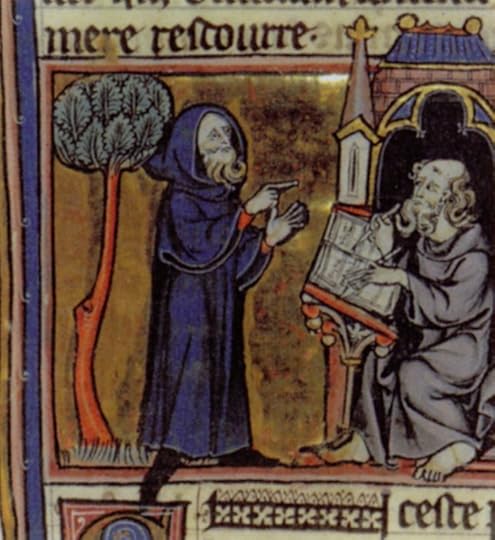 Medieval image of Marlin. By Unknown author – Scan from “Brockhaus Geschichtslexikon, vol. 2, Mittelalterliche Welt und frühe Neuzeit”, article “Geoffrey of Monmouth”, earlier uploaded to de.wikipedia. Originally in Histoire de Merlin by Robert de Boron), Public Domain, https://commons.wikimedia.org/w/index.php?curid=310472
Medieval image of Marlin. By Unknown author – Scan from “Brockhaus Geschichtslexikon, vol. 2, Mittelalterliche Welt und frühe Neuzeit”, article “Geoffrey of Monmouth”, earlier uploaded to de.wikipedia. Originally in Histoire de Merlin by Robert de Boron), Public Domain, https://commons.wikimedia.org/w/index.php?curid=310472I think it’s the idea that King Arthur might one day return that makes the story so powerful, and so enduring – that the greatest king in history is waiting to save the world again, and that the most iconic wizard of legend will be by his side. Driving around England, watching the mists roll down the hills, it’s easy to get swept up into the romance of it all. ‘King Arthur’ tours can be taken by dedicated fans, advertising “More than a myth or legend, King Arthur’s legacy is an adventure to be explored. Visit places in Bodmin and the rest of Cornwall that are central to stories about his life, and learn about where he lived and died. Visit Tintagel Castle and Merlin’s cave, and see the waterfalls at Nectan Glen where the knights of the round table were blessed before their quest for the holy grail.” The Legend of King Arthur tour on Viator
Imagine the excitement when an archivist in Cambridge University Library recently found a 700-year-old fragment of an Old French manuscript that expands the tale of Merlin, stitched into the binding of a 16th-Century register of property deeds. In Elizabethan times it had been repurposed as a book cover.
To avoid cutting the binding, library staff used CT scanning, multispectral imaging (MSI) and 3D modelling to access even folded parts of the fragment and enhance heavily faded areas of text.
In the further adventures of Merlin, he becomes a blind harpist, disappears into thin air, then reappears as a balding child who, for some reason, issues edicts to King Arthur without underwear on. He then asks to bear Arthur’s standard (a flag with his coat of arms) on the battlefield, and turns up with a magical dragon to breathe fire at the enemy.
More legend to add to the canon. Or is it?
 The Nine Dragon Wall in the Beihai Park, a large imperial garden in central Beijing. By splitbrain – Nine Dragons Wall detail in Behei Park, CC BY-SA 2.0, https://commons.wikimedia.org/w/index.php?curid=4881134
The Nine Dragon Wall in the Beihai Park, a large imperial garden in central Beijing. By splitbrain – Nine Dragons Wall detail in Behei Park, CC BY-SA 2.0, https://commons.wikimedia.org/w/index.php?curid=4881134We might ask if things like dragons ever existed, for example. I hope they did, that there was a time when magic permeated the world. There’s no evidence that dragons were real, other than numerous ancient writings.
“For using dragon’s bones, first cook odorous plants; bathe the bones twice in hot water, pound them to powder and put this in bags of gauze. Take a couple of young swallows and, after taking out their intestines and stomach, put the bags in the swallows and hang them over a well. After one night take the bags out of the swallows, rub the powder and mix it into medicines for strengthening the kidneys. The efficacy of such a medicine is as it were divine!”
–Chinese medical scholar Lei Xiao (AD 420-477)
The magic of the Merlin and King Arthur story is the magic, the idea that wonderful and mystical things existed in our world once upon a time. It’s an idea that’s particularly powerful in the 2000s.
 The_last_sleep_of_Arthur.jpg By Edward Burne-Jones – http://www.illusionsgallery.com/Arthur-avalon.html via English Wikipedia, Public Domain, https://commons.wikimedia.org/w/index.php?curid=859465
The_last_sleep_of_Arthur.jpg By Edward Burne-Jones – http://www.illusionsgallery.com/Arthur-avalon.html via English Wikipedia, Public Domain, https://commons.wikimedia.org/w/index.php?curid=859465The magic of the discovery lies in the remarkable techniques used to read the uncovered story. The university used Computed Tomography (CT) scanning to digitally penetrate the layers of parchment. It provided a 3D model of the fragment and the structure of the binding without dismantling the book. As a bonus, the scan also gave insight into 16th-century archival binding techniques.
Scans were able to create a 3D model of the manuscript using mirrors, prisms and other tools to photograph each section, some of which were either stitched into the binding or hidden inside folds, and then digitally assemble those so that the document could be read.
After all that, the team had to get past the wear on some of the fragments. They exposed the manuscript to light in different wavelengths to improve the readability of the text, and even highlight notations made in the margins.
This is considered a major find, which the Cambridge U researchers went to a great effort to recover. The pursuit of storytelling at its finest.
March 25, 2025
Libraries and Third Spaces
During the first COVID lockdowns, when you couldn’t walk around a neighbourhood without people crossing the street to avoid you, I found myself gravitating to our local botanic garden. I drove by one day, just escaping the four walls of our home for a little while, and found the parking lot gates at the garden wide open. No one was in the ticket booth, but a couple of other cars were there, so I pulled in tentatively, parked my car and got out to walk around. It was wonderful, having the freedom to stroll along the pathways on a cool spring day in the fresh air. There was no need to wear a mask – besides me, there were only a handful of other people.
I returned regularly. It became my ‘third place’, where I watched the landscape change in subtle ways, and shared brief conversations with fellow devotees amidst days of isolation. A woman I met suggested I head over to the Rock Garden to check out the spring hellebores. An older gentleman and I had regular chats while his more virus-timid wife walked several feet away. Some people just sat on blankets on the lawns. But we were all there for the same reasons: for fresh air, the comfort of nature, and the companionship, whether silent or conversational, of other human beings in those tension-fraught days.
 The almost-empty Niagara Falls Botanic Garden in April 2020 – by E. Jurus, all rights reserved
The almost-empty Niagara Falls Botanic Garden in April 2020 – by E. Jurus, all rights reservedWhat are “third places”?
They are social surroundings apart from our first place, our home, and our second place, usually work. They are places to be sociable, a milieu where we feel comfortable hanging out, without any pressure. They can be anything from a local pub to a workout gym to a church to a…garden.
In the COVID years, our first and second places often merged, which made the need for an additional place even more critical. My hubby was an essential worker and was going to his job daily, but by happenstance I chose to retire from full-time work just before the first lockdown. I spent three months tying things up in my job from a computer station on our dining room table, communicating by email or virtual meetings, but once that was done, I was stuck in the house, apart from long lines at the grocery stores. Our botanic garden was a lifeline for me.
Back when I was a teenager, I wouldn’t have spoken freely to anyone at the garden. I was inordinately shy, and for that period in my life, our local library was my third place. I didn’t have conversations there, except with the odd librarian and a friend who worked there part-time, but it was a place of community, of a shared love for books and reading. Libraries still serve the same functions today, and have embraced the communal aspect by holding children’s activities, workshops, adult speaker series (I was a regular guest speaker myself before the pandemic), even local author showcases.
I’ve participated in two of those myself so far, and have another coming up next month. Sometimes visitors buy a copy of my novels, and sometimes we just chat about reading, novels, the appeal of different genres, the importance of stories. Libraries are the literary version of that garden – public spaces where people with the same interests feel comfortable gathering together.
The concept of third places was developed by sociologist Ray Oldenburg in the 1980s. He and his co-author Karen Christensen for a book about it set out seven typical characteristics. They are
Open and inviting – a place where one can come and go freely, without an appointment, or an invitation.A place of belonging, informal and comfortableConveniently located – often in one’s own neighbourhood, like a pub, but for those of us who live in suburbs there are no such places and we have to drive, or take a bus.Unpretentious, as in nothing special required to visit, neither in status or finances.Where regulars we might recognize and associate with, congregate, and perhaps with a greeter (like a friendly librarian).Where conversation – including discussions and gossip – is the main activity.Of a light, playful and amicable mood.“Your third place is where you relax in public, where you encounter familiar faces and make new acquaintances.” White, Rebekah (July–August 2018). “A third place”. New Zealand Geographic (152): 6.
In my novels, while Tempus College is a ‘second’ place for both the staff and students, the Village, a replica of an old English town, really becomes a ‘third’ place for them – local, friendly (when not haunted), unpretentious and inviting – and each pub or tea room within it a breakout space within it. If you, as a reader, enjoy the Village, you’re entering the third place of the people who frequent it for a short while. Layers upon layers, especially as my novels are now available for lending at my local library, which has brought me full circle from my days as a reticent teenager.
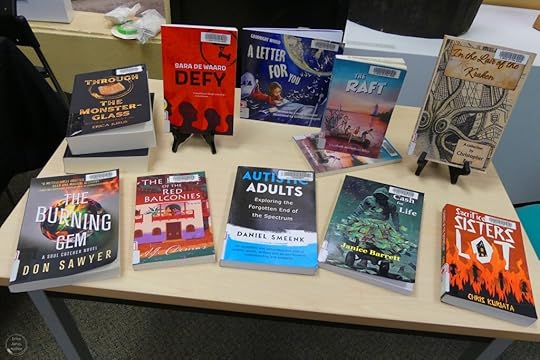 My novels in the St. Catharines Public Library – by E. Jurus, all rights reserved
My novels in the St. Catharines Public Library – by E. Jurus, all rights reservedWhat’s your favourite third place? I hope you have one – a place like the pub on the Cheers TV series, where “everyone knows your name”.
I’ll be at the Thorold Public Library on May 10, 2025 from 1pm to 4pm for their Local Author Showcase; maybe I’ll see you there!
March 18, 2025
Houses of mystery
If you were a 19th century archaeologist with an unholy Egyptian artifact in your possession, and you wanted to both keep it out of the hands of bad guys and protect your family, where would you put it? Why, a secret room in your mansion, of course.
At least, that was the solution of Ransford Monk, the adventuring great-grandfather of Standish Monk, a friend of my heroine’s late husband. Inside Reafen Hall, in West Sussex, England, there was a hidden room just large enough to house the acquisitions that Ransford didn’t want the public to know about, including a statuette of a black Jackal with rather unusual markings on it.
Despite the statuette’s confinement, the ghostly figure of a full-sized ancient Egyptian Jackal regularly haunted the mansion’s hallways over the ensuing decades. Ransford’s choice turned out not to have been the best idea, as Romy and the Monk family horrifyingly found out.
Houses with mysteries – concealed rooms or passageways, owners who don’t want to be seen, weird things in the attic, hauntings – make fertile settings for thriller or horror novels. All kinds of things can be hiding inside, waiting to be discovered at the worst possible moment.
Settings are the backbone of novels, whether a run-down tenement filled with poor people struggling to survive any way they can or an opulent villa where the residents all have their own skeletons in the closet. The settings become a character of their own, the stage for all the drama that’s going to unfold. Think of Psycho House in the famous Alfred Hitchcock film – so iconic that Universal Studios Hollywood featured it on their studio tour.
Numerous novelists have used them to their advantage, myself included. I was greatly entertained by an article I read in the Crime Reads newsletter I subscribe to, Architectural Misdirection: Seeking Out Secret Staircases and Hidden Rooms, by mystery novelist Gigi Pandian. Tonight, since I’m feeling a little under-the-weather, I’m going to share her insights with you and give you some ideas for books for your reading list.
Hope you enjoy, and if you want to find out what happened with the damned (literally) jackal statuette that Ransford Monk brought home from his forays into Egypt, read the first novel of my trilogy, Through the Monster-glass. If you start now, you can get caught up on the first two novels just in time to read the thrilling finale coming out this June!

March 11, 2025
Hitchcock: a Master Storyteller
“Give them pleasure. The same pleasure they have when they wake up from a nightmare.” Alfred Hitchcock
There’s a large maple tree in the centre of the circle I live on, and from time to time an unusual number of crows will gather on it early in the morning and caw ominously. It’s not predictable, or logical in any sense of the word – except perhaps in the birds’ minds. I should record it and sell it to Hollywood for a great sound effect.
Nothing happens. Eventually the crows reach some conclusion that makes sense to them and flap away. But in the great filmmaker Alfred Hitchcock’s mind, what would happen if they didn’t go away? What if they were pissed off at humans for some reason and decided to swoop down and attack, violently, mercilessly?
Hitchcock answered that very question in 1963 in one of his most intense and terrifying movies, The Birds. I’ve loved his movies since I first began watching them, and since tomorrow is Alfred Hitchcock Day, I thought it would be fun to look at how The Master of Suspense perfected his craft.
Alfred Hitchcock was born in East London, England in 1899. He originally wanted to be an engineer, but after his father died at a relatively young age, Alfred took a job as a technical clerk at a telegraph and cable company. After World War I, he began writing stories, and worked on ad campaigns for the telegraph company. He also developed a keen interest in movies. When Famous Players–Lasky opened a film studio in London, he created drawings for the title cards, sent them to the studio, and was hired on as a title-card designer.
The British workers at the studio were encouraged to try their hand at various aspects of the industry, and Hitchcock worked as a co-writer, art director and production manager on at least 18 silent films. He took his first stab at directing with the 1925 film The Pleasure Garden, but it was his subsequent movie, The Lodger: A Story of the London Fog, in which a woman suspects that her new lodger is the madman killing women in London, that introduced a couple of his signature elements: an innocent man on the run, and making a cameo appearance in the film. It was a commercial success, and in 1940 Hitchcock moved to Hollywood. The rest is history, as he produced a great body of unforgettable mysteries, thrillers and horror films.
Hitchcock’s trademark was the ability to create almost unbearable suspense as audiences became voyeurs through each movie’s surprisingly intimate window into the lives of the troubled characters.
There were a number of early influences that gave him a deep appreciation of what scared people or made them uneasy. He remembered as a child waking up at night to find himself alone in a dark house. It shook him badly. When he was five, for some reason his father sent his generally well-behaved son to the local police station with a note that prompted the officer to lock him in a cell briefly, saying, “This is what we do to naughty boys”; it induced a lifelong phobia of law enforcement.
Later, he was sent to a Jesuit grammar school where discipline came via a flat, hard strap on the palm. Since punishment was always administered at the end of the day, the boys had to sit in dread all day through their classes.
These experiences created in him a fondness for scaring the hell out of his audience. He wanted that sense of control, maybe as a reaction to the lack of it in his formative years. It was said that while other directors typically fixated on the ‘art’ of film-making, Hitchcock thrived on manipulation.
How did he do it so well?
Hitchcock understood that that there are common fears and desires we all share. He turned fear into a reward. He let his viewers make assumptions about the characters, then turned those on their heads so that the audience became disoriented and unsettled, completely unsure of what was going to happen next.
In the movie Psycho, his most famous film, the movie begins with the top-billed star, Janet Leigh, stealing money and running away to join her lover. The audience assumes that the crime and its consequences will be the main story.
(spoiler alert!)
Then the main character stops in a seedy hotel and gets murdered. The killer, Norman, who runs the hotel, becomes the new protagonist, even generating sympathy because of his crazy and cruel mother. The audience has no reason to believe that she’s no longer alive, until in a mind-bending twist it becomes clear that Norman has lost his grip on reality and keeps her shrivelled corpse around to ‘talk’ to.
To achieve the complete immersion of his audiences into the lives of the characters on the big screen, Hitchcock used little dialogue, preferring to show his characters’ reactions to the horrible things they’re going through with their eyes, hands and even feet. He adopted a technique introduced by Russian Film-maker Lev Kuleshov, which used three distinct shots: a Close – up, followed by a Point of View, then the character’s Reaction. He loved to use montages – sequential clips spliced together. In The Birds, e.g., there’s a powerful scene as Tippi Hedren is trapped in an all-glass phone booth being bombarded by angry birds, and her reactions show her sheer terror.
Hitchcock believed suspense was created when the audience knew something the character didn’t. A scene would play out as if there was nothing wrong, but with reminders to the viewers that danger was looming.
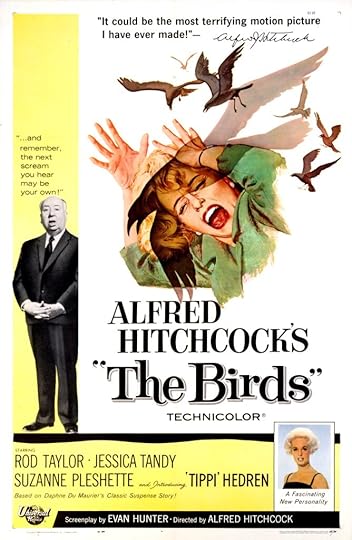 Theatrical poster for the film The Birds (1963) By Copyrighted by Universal Pictures Co., Inc.. – https://www.imdb.com/title/tt0056869/mediaviewer/rm1418251264, Public Domain, https://commons.wikimedia.org/w/index.php?curid=25318690
Theatrical poster for the film The Birds (1963) By Copyrighted by Universal Pictures Co., Inc.. – https://www.imdb.com/title/tt0056869/mediaviewer/rm1418251264, Public Domain, https://commons.wikimedia.org/w/index.php?curid=25318690The movie The Birds begins in San Francisco with a fairly unassuming ‘meet-cute’. Rod Taylor is an attractive, manly visitor who runs into cool, blond, somewhat notorious socialite Tippi Hedren in a pet store, wanting to buy a pair of love-birds for his sister’s birthday. He knows who she is, but pretends that he thinks she’s one of the staff, and she plays along. Eventually the truth comes out, and he leaves without making a purchase, but she decides to buy the birds and pursue him down the coast to the charming town of Bodega Bay, where he’s gone to visit his sister and string-clinging mother.
Hedren rents a boat to drop off the birds, but is attacked by a gull as she approaches the wharf. Taylor treats her wound, and invites her for dinner. Harmless enough, as we watch the growing romance between Hedren and Taylor, the suppressed jealousy of his ex-lover, who’s putting his new girlfriend up at her own home, and the disdain of his mother for the sophisticated newcomer who might steal her beloved son away from her.
But things begin to get strange. The mother’s hens start refusing to eat. A gull bombs a front door and dies. Birds attack the sister’s outdoor birthday party the next day. The bird attacks become increasing violent, and there’s a mesmerizing and unnerving scene where Hedren offers to pick up the sister at school and sits outside, unaware of the mass of crows gathering silently behind her. We the viewers know what’s coming but feel utter helplessness to prevent it. We have no idea more idea than the characters as to why this is all happening, why nature has gone berserk, and we struggle right along with them to make some sense of it.
If you haven’t yet seen the movie, I won’t spoil the rest for you, but the review by Rotten Tomatoes says it all: “Proving once again that build-up is the key to suspense, Alfred Hitchcock successfully turned birds into some of the most terrifying villains in horror history.” The movie’s bird-attack sequences earned it a nomination for Best Special Effects.
Hitchcock’s style was honed during the days of the strict censorship known as the Hays Code. He learned to tell his stories of obsession, sexual frustration and murder using innuendo and subtext, powerful tools that brought his audiences’ imaginations into play.
“I believe in putting the horror in the minds of the audience, and not necessarily on the screen.” Alfred Hitchcock
In a 1963 interview with Peter Bogdanovich, Hitchcock was asked: “You never watch your films with an audience. Don’t you miss hearing them scream?” His reply was, “No. I can hear them when I’m making the picture.”
I feel the same way when I’m writing something creepy – or funny, or sad. The reactions of my readers are in my head throughout. As my trilogy wraps up, it features some really intense moments, and I hope that I approach Hitchcock’s mastery in even a small way at gauging my audience’s response to it all.



